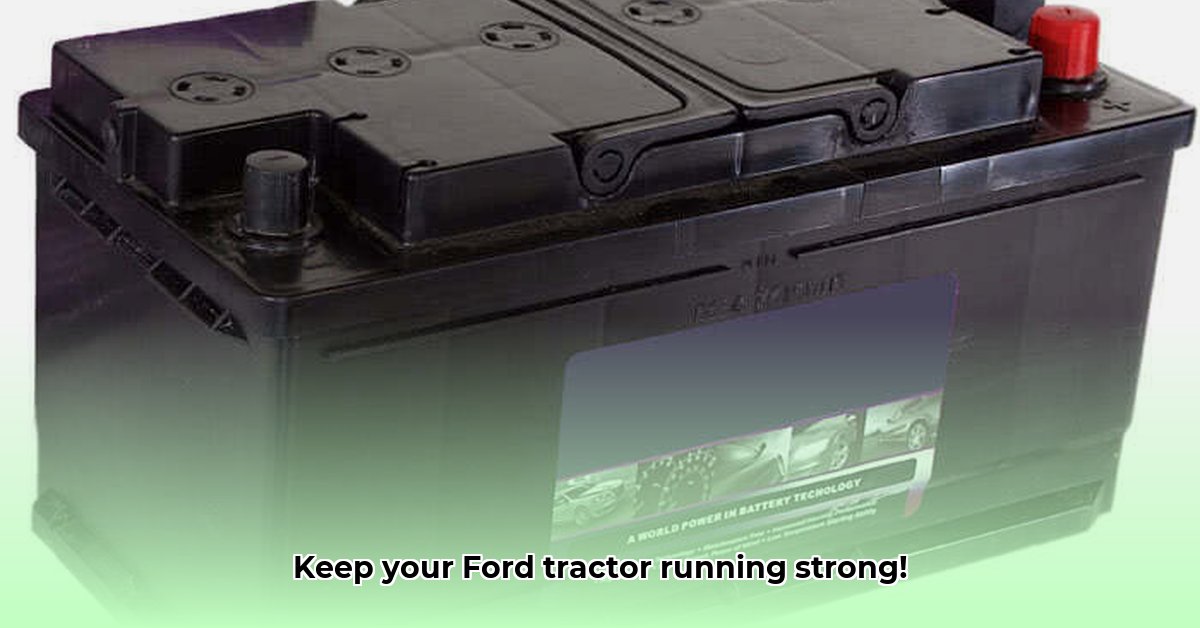
Understanding Your Tractor's Power Needs: Choosing the Right Battery
Choosing the right battery for your Ford tractor is crucial for maximizing efficiency and minimizing downtime. This isn't just about starting your engine; it's about ensuring reliable operation and making a sustainable choice for your farm. This guide will help you navigate the options, understand the trade-offs, and make an informed decision. Did you know that a properly chosen battery can extend the life of your tractor's electrical system by up to 20%? For more on Ford tractor maintenance, check out this helpful resource: Ford Tractor Info.
Decoding Tractor Battery Technology
Several battery types power modern tractors, each with specific advantages and disadvantages. Choosing the right one depends on your individual farming operation's needs and priorities.
Lead-Acid Batteries: The Familiar Workhorse
Lead-acid batteries are the traditional choice, known for their affordability and widespread availability. However, they have a shorter lifespan (typically 3-5 years) than newer technologies and require regular maintenance, including checking electrolyte levels and cleaning terminals. The lead content also presents environmental concerns during manufacturing and disposal. "Lead-acid batteries are like the trusty old pickup truck—reliable, but not the most fuel-efficient," says Dr. Anya Sharma, Agricultural Engineer at Cornell University.
Lithium-ion Batteries: High-Performance Power
Lithium-ion batteries offer significant advantages: longer lifespans (5-10 years or more), faster charging, and higher energy density (meaning more power in a smaller package). They're more expensive upfront, but this cost is often offset by their extended lifespan and reduced replacement frequency. While more environmentally friendly than lead-acid in terms of operational emissions, responsible recycling is crucial at the end of their life.
Solid-State Batteries: The Future of Farm Power
Solid-state batteries represent the cutting edge of battery technology. They promise even longer lifespans, improved safety, and higher energy density than lithium-ion. However, they are currently very expensive and not widely available for agricultural applications. This technology is rapidly developing and holds immense potential for the future of sustainable farming.
Battery Comparison Table
| Battery Type | Advantages | Disadvantages | Lifespan (Years) | Cost | Environmental Impact |
|---|---|---|---|---|---|
| Lead-Acid | Affordable, widely available, familiar technology | Shorter lifespan, requires maintenance, contains lead, heavier | 3-5 | Low | Moderate |
| Lithium-ion | Longer lifespan, faster charging, higher energy density, lighter | Higher initial cost, temperature sensitivity | 5-10 | Medium to High | Lower than lead-acid |
| Solid-State | Longest projected lifespan, highest energy density, improved safety | Very high cost, limited availability, technology still emerging | 10+ (projected) | Very High | Potentially very low |
Choosing the Right Battery: A Step-by-Step Guide
Selecting the ideal battery involves considering several factors:
Tractor Size and Power Needs: Larger tractors and those with more powerful engines require higher Cold Cranking Amps (CCA) ratings – the battery's ability to power the starter motor, especially in cold temperatures.
Usage Frequency: Daily use demands a more durable, higher-capacity battery than seasonal use. Frequent starts and long operating times necessitate higher reserve capacity (RC).
Climate: Extreme temperatures (both hot and cold) significantly affect battery performance. Consider a battery specifically designed for your climate.
Budget: While upfront costs are a factor, consider the total cost of ownership over the battery's lifespan. A higher initial cost might be offset by extended lifespan and reduced replacement costs.
Environmental Considerations: Prioritize batteries with lower environmental impact throughout their life cycle, including materials, manufacturing, and disposal.
Battery Maintenance and Care: Extending Battery Life
Proper maintenance is crucial for maximizing battery lifespan, regardless of type:
Clean Terminals Regularly: Corrosion buildup reduces performance; clean terminals with a wire brush and baking soda solution.
Check Fluid Levels (Lead-Acid Only): For lead-acid batteries, regularly check the electrolyte fluid level and add distilled water if needed.
Proper Charging: Use the correct charger and avoid overcharging, which can damage the battery.
Store Properly: During periods of inactivity, store the battery in a cool, dry place in a fully charged state.
Sustainable Disposal Practices: Protecting the Environment
Responsible disposal is crucial, especially for lead-acid batteries due to their lead content. Check with your local recycling center or auto parts store for proper disposal options and recycling programs. Lithium-ion batteries also require specialized recycling procedures.
Conclusion: Sustainable Power for a Sustainable Future
Choosing the right tractor battery is an investment in your farm's long-term sustainability and efficiency. By carefully considering the factors outlined in this guide, you can select a battery that meets your needs, minimizes environmental impact, and keeps your Ford tractor running smoothly for years to come. Remember that even small improvements in battery efficiency can significantly enhance your farm's overall sustainability and profitability.